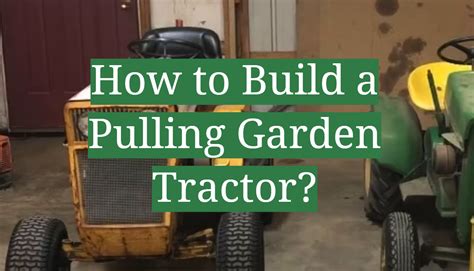DIY Garden Tractor Pulling: Secrets of the Pros
Garden tractor pulling might sound like a niche hobby, but for enthusiasts, it's a thrilling blend of engineering, skill, and horsepower. This isn't your grandpa's leisurely gardening; this is about modifying and pushing machines to their absolute limits. This article dives into the world of DIY garden tractor pulling, revealing secrets and techniques used by the pros to build competitive machines and dominate the competition.
What is Garden Tractor Pulling?
Garden tractor pulling involves competing with modified garden tractors to see which can pull the heaviest weight the farthest distance. These aren't your average John Deere or Cub Cadet; they're heavily modified machines boasting significant increases in horsepower, traction, and durability. The goal is simple: pull the most weight for the longest distance. Sounds straightforward, but achieving this requires significant mechanical know-how and strategic modifications.
Choosing the Right Tractor: The Foundation of Success
The choice of your base tractor is crucial. While any garden tractor can be modified, some models are better suited for pulling than others. Look for tractors with:
- Robust Frames: A strong frame is essential to withstand the immense stress of pulling heavy weights. Look for heavier-gauge steel and reinforced components.
- Suitable Engine: While engine swaps are common, starting with a tractor possessing a relatively powerful engine will save time and money. Consider engines with ample torque.
- Accessible Parts: Easy access to parts for repairs and modifications is vital.
Popular base tractors among pullers often include older models known for their sturdiness, but any solid machine can become a contender with the right modifications.
H2: Essential Modifications: Unleashing the Beast
Transforming a garden tractor into a pulling champion requires a series of strategic modifications. These upgrades focus on increasing power, improving traction, and strengthening the machine's overall structure.
Engine Enhancements: Boosting Horsepower
- Engine Swaps: Many pullers opt for larger, more powerful engines. This often involves significant fabrication and custom work. Common swaps include industrial engines or even modified automotive engines.
- Turbocharging/Supercharging: Forcing more air into the engine dramatically increases horsepower and torque. This requires expertise in engine tuning and modification.
- Fuel System Upgrades: High-performance fuel pumps, injectors, and carburetors are crucial to provide the engine with the fuel it needs.
Transmission Tweaks: Power Transfer Optimization
- Gear Ratios: Adjusting gear ratios to optimize pulling power is essential. Lower gear ratios allow the engine to operate at its peak torque output during the pull.
- Strengthening the Transmission: The transmission takes a severe beating. Reinforcements, upgrades, and even custom transmissions might be necessary to handle the increased power.
Drivetrain Improvements: Maximizing Traction
- Tires and Wheels: Massive, heavy-duty tires with aggressive tread patterns are crucial for maximum traction. These are often custom-built or modified for optimal grip. Consider wheel weights as well.
- Differential Modifications: Locking differentials ensure power is evenly distributed to both rear wheels, preventing wheel spin and maximizing traction.
- Axle Upgrades: Reinforcing or replacing the axles is often necessary to withstand the increased stress from the powerful engine and aggressive tires.
Chassis Reinforcement: Building a Solid Foundation
- Frame Strengthening: The tractor's frame must be significantly strengthened to handle the immense forces involved in pulling. Welding reinforcements, bracing, and even custom roll cages are common.
H2: Secrets from the Pros: Beyond the Basics
While the modifications above are essential, the pros know a few extra tricks that give them an edge:
- Weight Distribution: Optimizing weight distribution is critical for traction and stability. Strategic placement of weights can make a significant difference.
- Suspension Tuning: While not as common as in other motorsport disciplines, fine-tuning the suspension (if applicable) can affect traction and stability.
- Aerodynamics (Surprisingly!): Believe it or not, even a small amount of aerodynamic improvement can help at higher speeds.
H2: Safety First: Never Compromise on Safety
Garden tractor pulling can be dangerous. Always prioritize safety by:
- Using Proper Safety Gear: This includes eye protection, gloves, closed-toe shoes, and hearing protection.
- Regular Maintenance: Regularly inspect and maintain your tractor to avoid malfunctions.
- Experienced Supervision: If you are new to the sport, work with experienced pullers.
- Secure Pulling Area: Ensure the pulling area is safe and free from obstacles.
H2: Where to Start: Getting Involved in Garden Tractor Pulling
Getting started in garden tractor pulling can be rewarding. Begin by:
- Researching Local Clubs: Connect with local garden tractor pulling clubs. They offer invaluable support, advice, and camaraderie.
- Attending Events: Watching experienced pullers can provide valuable insights into techniques and modifications.
- Starting Small: Begin with simpler modifications and gradually increase complexity as you gain experience.
DIY garden tractor pulling is a challenging but incredibly rewarding hobby. By carefully planning, executing modifications, and prioritizing safety, you can build a competitive machine and experience the thrill of the pull. Remember, it's all about passion, perseverance, and a healthy dose of mechanical ingenuity.

